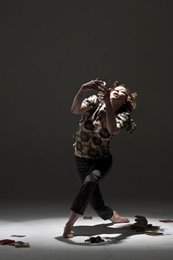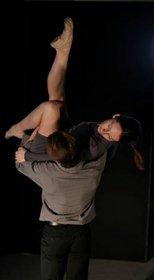Down the half-lit corridor, the figure in a print frock walked backwards, moving slowly on screen into our view and that of the four dancers on stage. From that moment, we were watching two performances in parallel, on film and on stage, our attention drawn from one to the other in turn, the dancers both present and absent at the same time.
 Body and Forgetting, a film/live performance collaboration between choreographer Liz Roche and film/theatre director Alan Gilsenan, was a dreamlike seamless partnering – and was gently but insistently galvanising. The work exploited cinematic possibilities as it explored the world of recovering and losing memories. We watched a dancer’s body on stage instinctively recreating a half remembered gesture. Immediately, propelled by Denis Roche’s urgent score, our attention would switch to the moving picture screen. There that very movement and gesture would be uncannily replicated or echoed by one of these shadowy dancing figures. It could be an inclined head, a signature swivelled body, a fisted hand under the chin, or two hands splayed on a back, elbows akimbo.
Body and Forgetting, a film/live performance collaboration between choreographer Liz Roche and film/theatre director Alan Gilsenan, was a dreamlike seamless partnering – and was gently but insistently galvanising. The work exploited cinematic possibilities as it explored the world of recovering and losing memories. We watched a dancer’s body on stage instinctively recreating a half remembered gesture. Immediately, propelled by Denis Roche’s urgent score, our attention would switch to the moving picture screen. There that very movement and gesture would be uncannily replicated or echoed by one of these shadowy dancing figures. It could be an inclined head, a signature swivelled body, a fisted hand under the chin, or two hands splayed on a back, elbows akimbo.
Sometimes we strained to recognise generational similarities and familiar movements between the dancers/characters. Our peripheral vision, ever alert, noted Grant McLay, Katherine O’Malley and Jenny Roche whose presences inhabited the unchanging film scene of a glassed-in hallway, as shadowy and narrow as any institution. At the same time we absorbed the careful textured movements of the external dancers looking in – Alexandre Iseli, Lucia Kickham, Liv O’Donoghue and the bi-locating Justine Cooper – as they merged, collided and reflected off their selves on screen.
Roche’s narrative was tantalising and elusive, a development of a recent work, Fast Portraits, where dancers created images of t.jpg.aspx%3Fwidth=260&height=172) hemselves, other lives, as though from posed photographs. Here, although images are now captured on film, there is still no solution to the act of forgetting and the unreliability of memory. The dancers on screen and stage regularly remove their cardigans and jackets and then don them again later, as though exposing a memory and then concealing it or forgetting all over again. Figures sidle down the aisles on screen, slipping in and out of the recesses like thoughts and fragments vanishing into the recesses of memory and the unconscious.
hemselves, other lives, as though from posed photographs. Here, although images are now captured on film, there is still no solution to the act of forgetting and the unreliability of memory. The dancers on screen and stage regularly remove their cardigans and jackets and then don them again later, as though exposing a memory and then concealing it or forgetting all over again. Figures sidle down the aisles on screen, slipping in and out of the recesses like thoughts and fragments vanishing into the recesses of memory and the unconscious.
The exploration of loss extended to souvenirs, the personal objects and possessions which trigger memories. A dancer on stage dropped a clutter of books and papers but was quickly supported by the others, seeming sensitive to his fear of separation from them. They collectively gathered all together, squashing them between his limbs, even creating small leaning towers of them on his back. On screen, the small possessions of the screen character of Justine Cooper were scattered around her as she lay alone on the floor; among them a rose, a notebook, a tambourine, a spool of ribbon. This was a prelude to a wonderful duet where on stage Cooper and Iseli, their heads hidden in loose cloths like Magritte’s ‘Les Amants’ folded and turned their bodies in and around one another, mirroring Cooper on screen who echoed their movements, her tambourine as partner, replaying the body’s undulations and memories of another duet at another time.
 Lost and sundered memories came into play in the second part of this double bill which opened the Dublin Dance Festival. The Wake, choreographed by Sarah Dowling was like a small beautifully formed coda to Roche’s extended journeying into the land of forgetting and remembering. In a simple tableau, Dowling brought us movingly to another turn on the road of loss, grief and separation and the need to remember.
Lost and sundered memories came into play in the second part of this double bill which opened the Dublin Dance Festival. The Wake, choreographed by Sarah Dowling was like a small beautifully formed coda to Roche’s extended journeying into the land of forgetting and remembering. In a simple tableau, Dowling brought us movingly to another turn on the road of loss, grief and separation and the need to remember.
A young woman is about to bury her lover and husband but before she prepares him for his waking, the last communal salute to his life, we are witness to her personal grieving, graceful and dignified. We are offered a glimpse into a shared life now riven apart, a young life caught short. That spirit of youthfulness soared in the performances, from the pure sean nós lamentation sung by Saileog Ní Cheannabháin and the sweet sadness of Ruth Elder’s violin playing, to the almost ethereal fluency of the dance. The nuance of the unadorned caoineadh seemed to seep particularly into the exquisite performances of the two dancers from The Royal Ballet. Kristen McNally and Thomas Whitehead imbued Dowling’s soft but visceral movements with an intensity and tenderness, a passion and recklessness in the lifts and contact that was remarkable, while Nally’s extended leaps created yearning arcs of her limbs which were as thrilling as they were touching.
As remembered shared joy of the duet dissolved into sorrow, the quiet earthy physicality of the dance evaporated into dreamlike oblivion. The secret of The Wake’s emotional impact was in its simplicity and intuitive choices. It was both poetic and elegiac.
Seona Mac Réamoinn